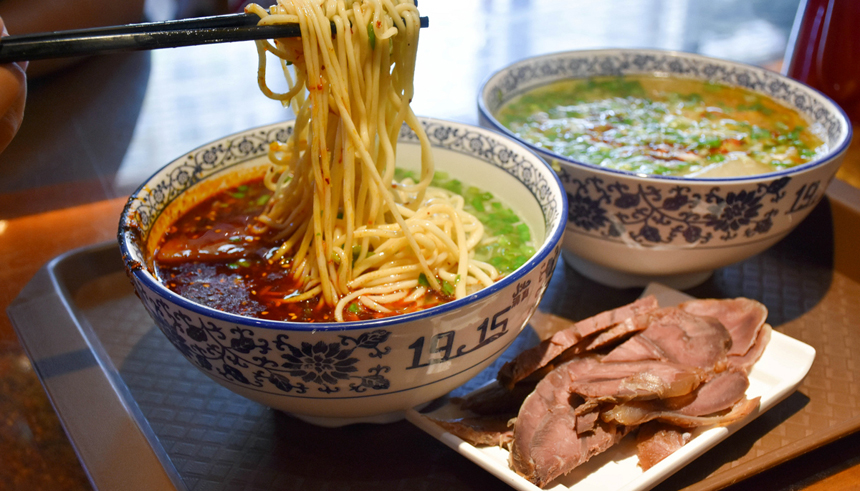East West Lifestyle
Recipes of Asia: Lanzhou Beef Noodle Soup
By Clarissa Wei

Food blogger Clarissa Wei learns to make beef noodle soup in north-central China.
In the city of Lanzhou, beef noodle soup stores are so commonplace, you’d be hard-pressed not to stumble across one. There’s a beef noodle soup joint on nearly every corner. According to conservative estimates, there are 20,000 Lanzhou beef noodle soup shops across the country. It is to China as McDonald’s is to the United States, and ramen is to Japan.
Local lore says that the dish was invented in 1915 by a Muslim man of Hui descent named Ma Baozi. In accordance with that religion, most noodle restaurants are still strictly halal, but these days, the beef noodle industry has saturated markets far beyond the Muslim community. In Lanzhou, beef noodle soup is consumed as early as 6 in the morning. It has become a breakfast staple for locals and a priority for visitors.

"Beef noodle soup is to China as McDonald’s is to the United States."
Located in north-central China, Lanzhou is the capital of Gansu — a semi-arid province known for its vast deserts, mountains and an occasional oasis. The city is built alongside the Yellow River, which has been the lifeblood of residents for centuries. It is a source of pride for locals and it is, indeed, a murky yellow-brown color. In the summer, Lanzhou’s climate is hot and dry. The city is flanked by hills. It is not unlike Los Angeles. In fact, I felt more at home in Lanzhou than in any other Chinese city. And, like Los Angeles, the traffic in Lanzhou is perpetually horrendous. It is one of the few cities in China where taxies are legally allowed to ride-share.
“That’s how I met my husband,” Vicky Zhou told me.
I met Vicky and her husband through my Airbnb host and, upon learning that I write about food, they took it upon themselves to show me around the city. They’re fiercely passionate about the local food scene and stuffed me with local bites. I learned that sheep offal and sheep head are local favorites. Pork is practically nonexistent in Lanzhou because many of the residents are Muslim.
With Vicky at the helm, I spent my four days in Lanzhou immersed in a crash course on the food scene. We ate the local cold noodle, which is made out of Agriophyllum squarrosum — a local desert plant. It’s not very al dente, but because it’s served cold, it is a welcoming respite to the heat. Lamb skewers were sufficiently fatty and the best I’ve had yet.
The highlight of my Lanzhou trip was a visit to a local beef noodle soup school (www.lmpxzx.com). Because of sheer demand, these schools have popped up across the region. There are 15-, 30-, and 40-day courses and students come from all over China. The key to a great bowl of noodle soup is the noodles, the students tell me. Lanzhou beef noodles are hand-pulled; a chunk of dough is roped through the fingers over and over until it becomes thin and noodle-like. There are more than nine different types of widths and shapes a noodle can take on.

"The key to a great bowl of noodle soup is the noodles."
Like most noodles around the world, the core ingredients are flour and water. But in Lanzhou, a sprinkle of penghuicao, known as Halogeton in English, renders the flour more flexible and lean.
I quickly learned the hard way that the noodle making couldn’t be learned via a recipe. Variables like humidity and the strength of one’s hands can’t be accounted for on paper. In-person practice is the only way to learn.
Luckily, I did obtain some of the handouts students are given. Here is a recipe on how to make the soup. For the noodles, store-bought Chinese noodles will just have to do. The spice packet ingredient list is a modified version of what they actually use, as a lot of the spices aren’t readily available in the United States. I’ve included them*, however, at the bottom for the curious.
Lanzhou Beef Noodle Soup
Time: 8 hours
Active cooking time: 1.5 hours
Servings: 3
Ingredients:
- 1 pound beef shanks
- 2 pounds beef bones
- 7 cups water
- Spice mix (see below)
- 1/2 tablespoon salt
- 1/2 of a small Chinese turnip, sliced thinly
- 1/2 pound fresh wheat noodles
- Chili pepper oil, to taste
- 2 chopped scallions
- Handful chopped cilantro
- 1/2 knob of chopped ginger
Spice mix (put in a cheesecloth):
- 1/2 teaspoon Chinese peppercorn
- 1/2 teaspoon ginger powder
- 1/2 teaspoon white pepper
- 1/2 small cinnamon stick
- 1/2 teaspoon clove
- 1/2 teaspoon fennel
- 1 star anise
- 1 bay leaf
Directions:
- Put the beef shanks and bones in a large pot and soak in cold water for three to four hours. After soaking, bring shanks to a boil. You will see brown foam float to the top. Discard the water. Remove foam from the shanks, discard.
- Pour water in the pot until it covers the meat. Turn to high heat. Wait until boiling. Add spice mix.
- After mixture boils, turn the heat down to low. After half an hour, add salt. Let it simmer for three hours on low heat.
- Add sliced turnip and continue simmering for another hour.
- Take out the beef and set aside. Cut into thin slices. Save the broth. Remove spice packet.
- Cook noodles in a separate pot according to package instructions.
- In a serving bowl, combine the noodles with the broth.
- Garnish with chili pepper oil, chopped scallions, chopped ginger, and cilantro.
*Amomum tsaoko, Kaempferia galanga, Alpinia hainanensis K. Schum., Myristica fragrans (nutmeg), Chavica roxburghii
Subscribe to the Reach Further Newsletter
Get inspiring stories in your inbox every month.


